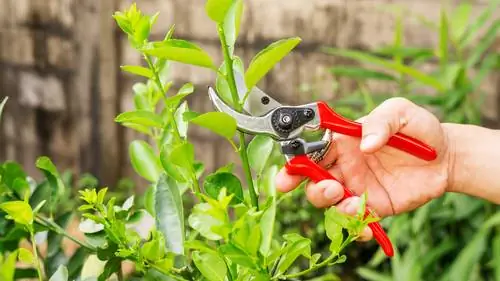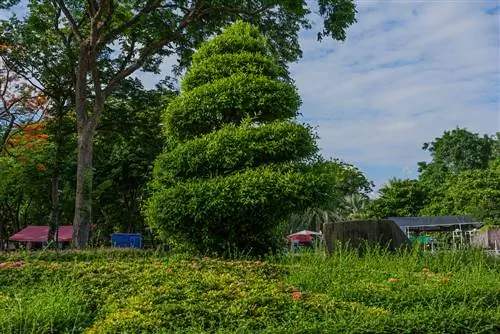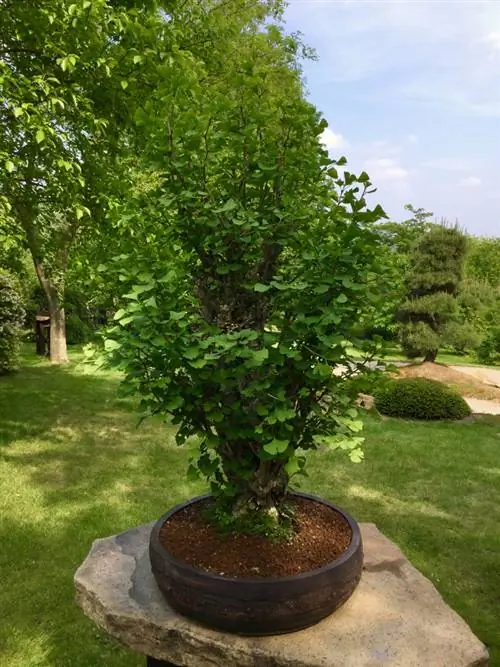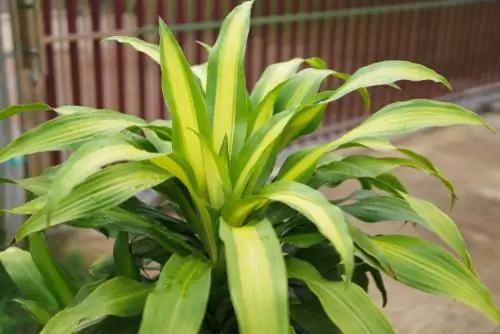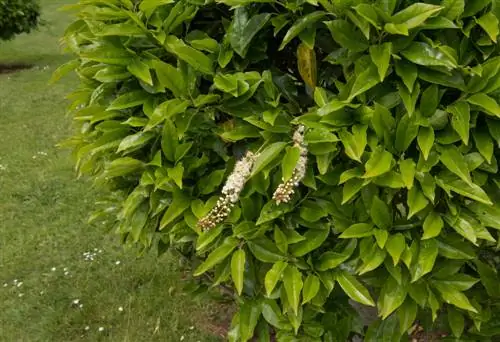- Author admin [email protected].
- Public 2023-12-16 16:46.
- Last modified 2025-01-23 11:21.
The lemon tree has a penchant for gesturing back and forth with its branches. With a planned topiary you can bring the Mediterranean beauty to the fore. Read all the instructions for perfect cut care in this tutorial. This is how you prune a citrus tree correctly.
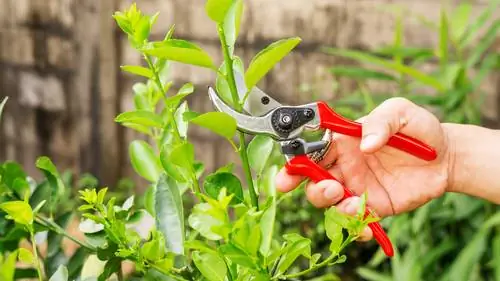
How to properly prune a lemon tree?
To properly prune a lemon tree, carry out training pruning in February for a harmonious crown. Remove competing shoots, shorten leading branches by a third and cut directly in front of buds or leaves. If necessary, carry out a maintenance cut later for thinning.
Why does a cut make sense?
Evergreen foliage, picturesque flowers and bright yellow fruits raise doubts as to whether pruning makes sense. In fact, a lemon tree clearly benefits from an occasional topiary. By nature, citrus trees tend to grow sparsely and misshapenly. A harmonious crown is a rarity.
The main cause is low top funding. This is the name given to the property of native trees to sprout more strongly on the top buds of their shoots than on buds positioned further down. The development of well-structured crowns of apple or plum trees is primarily based on this growth law.
In contrast, a lemon tree rarely forms a single vertical central shoot. Rather, growth is characterized by several equal shoots that compete with each other. Furthermore, young shoots often sprout from lateral buds and are significantly stronger than the main shoot. This tutorial gets to the heart of the types of pruning you can do to correct a disorganized lemon tree.
Cutting types and dates
The best time to prune a lemon tree is inFebruary This applies equally to all types of pruning, from training to maintenance to rejuvenation. Although you can prune your lemon at any time of the year, an appointment in early spring offers the ideal conditions. Primarily, the time window for regeneration is open long enough for the crown to easily compensate for the loss of substance.
The following table provides an overview of all sensible cutting types with information on recommended appointment options:
| Cut style | Goal/Occasion | Appointment option I | Appointment option II |
|---|---|---|---|
| Educational Cut | harmonious crown structure | 1. until 3rd year mid-February | 1. until 3rd year in winter |
| Conservation cut | Thinning out the crown, promoting fruit wood | from the 3rd or 4th year in mid to late February | from the 3rd or 4th year after the harvest |
| Rejuvenation cut | revitalize old lemons | End of December to end of February | none |
Raising a shapely crown
With a planned training pruning you can direct the growth into a harmonious crown structure. If the care plan includes pruning every spring for the first three years, the effort will be rewarded with a blooming lemon tree whose well-formed crown attracts everyone's attention. On top of that, pruning care is reduced to an occasional shape and maintenance pruning. How to cut correctly:
- Best time is mid to late February
- Designate the strongest central shoot as the trunk and attach or tie it to the vertical support rod
- Cut off all other ground shoots at the base as possible competitors
- Select three to four evenly arranged, strong side branches on the central shoot
- Cut back side branches so that their tips are in the sap level
- In the second and third year, shorten the scaffolding shoots byshorten by a third for strong branching
A skillful pruning of the lemon tree creates a crown with these components: vertical central shoot as a trunk, three to four evenly distributed leading branches in a sap balance.
If more than four side shoots are considered, choose those with an angle between 90° and 45° to the central shoot. Also pay attention to ascattering of the leading branches The starting points of the scaffolding shoots should not be at the same height on the trunk.
Observe cutting guide
Expert cutting is a key factor in achieving a perfect result. Always trim branches of a lemon tree crownjust before a bud or a leaf If you cut too far away from the eye or leaf, a shoot stub will remain, which poses the risk of rot and pest infestation. The distance between the interface and the vegetation point should not be greater than 2 to 4 millimeters.
Tip
The instructions in this pruning tutorial can be seamlessly transferred to the pruning care of comparable citrus trees, such as tangerine, orange and lime trees. Furthermore, the differences to cutting oleander and olive trees are minimal.
Preserve crown shape
Once the crown has been built up, the pruning care culminates in an occasional shape and maintenance pruning. As the illustration below illustrates, you should always thin out the crown if it becomes too dense. A light-flooded structure guarantees that white flowers and bright yellow lemons will also form inside. Another reason to use scissors are excessively long branches protruding from the crown shape and exhausted, hanging fruit wood. How to cut correctly:
- Cut out dead branches in advance
- Cut off shoots that point towards the inside of the crown or are otherwise unfavorably positioned at the base
- Twigs protruding from the crown shape are cut back to a leaf or a side shoot
- Cut off the weaker branches from parallel or crossing branches
Finally, dedicate yourself to empty branches. To promote the growth of young fruit wood, cut back by half all branches that last bore lemons and are now leaning to the ground when exhausted. To ensure that the cut does not leave a gap at this point, you should remove the relevant fruit wood. With this cutting technique, you place the scissors where a young side shoot branches off.
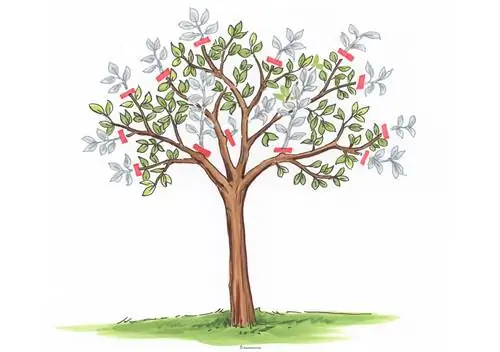
Cut a lemon tree to shape if necessary. Cut off dead wood and steep shoots at the base. Cut overly long shoots just above a leaf or favorable side shoot. If a branch has borne fruit, shorten it by a third or half using a derivation cut.
Excursus
Remove wild shoots promptly
Premium varieties are often grafted onto bitter orange seedlings. This rootstock tends to sprout numerous wild shoots. Equipped with unbridled growth, the cheeky wildlings strive to overgrow the noble crown and rob it of valuable nutrients. The uninvited guests can be identified by a different leaf shape. Ideally, you will discover a wild shoot while it is still young and unwoody. Tear it off along with its astring. Has the wild water shoot made its way through and is already woody? Then cut the bark on the lemon tree horizontally below the starting point and break off the wild shoot downwards.
Rejuvenate old lemon tree in stages
Proud owners of an elderly lemon tree are sometimes confronted with an increasingly bare, rotten crown. With a strong cut you can turn back the wheel of time and breathe new life into an old lemon. As with all trees, in this case too, a strong cut results in equally strong growth. To ensure that a rejuvenation cut is a perfect success, you should stay on the ball after the first stage and monitor the growth.
First stage
The good-natured tolerance of pruning of a lemon allows a courageous approach. One of the many talents of Citrus limon is that the trees sprout freshly from sleeping eyes. How to complete the first stage of rejuvenation with flying colors:
- In February, cut back all thick branches to 10 to 15 cm short cones
- Smooth cuts with a sharp knife
- Wound surfacesdo not coat with tree wax or similar products
After cutting, repot the lemon tree into fresh substrate. So that the citrus tree can recover from the strain, a partially shaded location is recommended for the following three to four weeks. This year's flowers will no longer bloom after the radical pruning measures. In return, lively budding sets in.
Second stage
The second stage of rejuvenation begins in the same year. Numerous new shoots sprout from the cones. Choose one or two of the strongest specimens. Everyone else has to go. To promote branching on young wood, the shoots are trimmed in summer. You can do this by grasping the shoot tips just above a bud between your thumb and forefinger and snapping them off. You can easily remove dried cone residue after one to two years.
Background
Steep shoots do not bloom or bear fruit
With tightly upright shoots, a lemon tree strives towards the sunlight as quickly as possible. The growth law of peak promotion rules here, with reserve substances being pumped primarily into leaf and shoot buds at the highest point. At this point, the citrus tree shows little interest in the strenuous formation of flowers and fruits. There are two options for dealing with steep shoots: cut them off completely or spread them out into a flattened position at an ideal 60° angle to the trunk or scaffold branch.
Frequently asked questions
Are lemon trees self-fertile?
With a few exceptions, all citrus species are self-fertile. One tree is enough to produce a harvest of juicy lemons. As with most fruit trees, the combination of two different varieties is beneficial for flowering and harvest yield.
Yesterday I bought an Amalfi lemon tree in a 3.5 liter pot. Should I transplant the tree and cut it?
A 3.5 liter pot is clearly too small for a lemon tree. Immediately repot the tree into a container with a volume of 8 to 10 liters and fresh, loose, permeable citrus soil (€19.00 at Amazon). You should take this opportunity to start raising a beautiful crown. To do this, tie the central shoot to a vertical rod so that it grows straight. Cut off shoots that compete with the future trunk at the base. As a crown framework, choose four side branches as future leading branches. Shorten this by a third to promote growth and stability.
Is a lemon tree hardy if it is grafted onto a frost-hardy base?
If you buy a lemon tree from a specialist retailer, you will receive a refined tree. Here a scion was combined with a robust root base. The scion itself comes from an established lemon tree that has already borne fruit. This ensures that even small lemon trees in the pot can bloom and bear fruit. The rootstock is usually the almost winter-hardy bitter orange or three-leaf orange. However, frost tolerance has no effect on the scion. A lemon tree north of the Alps always depends on a frost-free winter quarters.
Over the summer my lemon tree in the pot grew too big for its winter quarters. Can I reduce the size of the crown before putting it away? What should you pay attention to?
You can prune a lemon tree at any time of the year. It is easily possible to reduce the size of the crown before putting it away so that the tree fits into the winter quarters. Please make sure to cut overly long shoots just before a bud, a leaf or a short side shoot. If your lemon tree bears unripe fruit, you can leave it hanging until it is fully ripe.
When are lemons ripe?
You can recognize a ripe lemon by two criteria: the peel is shiny and gives way under slight pressure. Furthermore, a lemon is ready to harvest when the fruit is fully grown. The correct size depends on the citrus variety being cultivated. By the way, the color says nothing about whether a lemon is ripe or not. Green fruits can certainly be ripe for consumption. Lemons only get their yellow color under the influence of cool night temperatures. A lemon tree in a temperate winter garden with continuous room temperatures gives you ripe lemons that don't sparkle, like a sapphire.
Should lemons be picked or cut when harvesting?
Lemons are characterized by a firm connection to their supporting branch. As a result, picking ripe fruit runs the risk of tearing or damaging the branch as well. In practice, it has proven to be a good idea to cut off ripe lemons with scissors. Place the harvest cutting directly on the fruit. Alternatively, cut off a complete fruit shoot including several fruits and leaves.
The 3 most common cutting mistakes
If short or long stubs remain after cutting, rot and disease are inevitable. Without occasional maintenance pruning, a lemon crown degenerates into an impenetrable, flowerless tangle of branches. Anyone who allows wild shoots to grow on the lemon tree will struggle with an overgrown crown. This table summarizes the three most common cutting errors with tips for skillful prevention:
| Cutting errors | malicious image | Prevention |
|---|---|---|
| cut into tenons | Spread of disease and rot | Always cut off shoots directly at the base |
| never photographed | dense network of branches, bald, flowerless shoots | Thinning out the crown every few years |
| Wild shoots not removed | overgrown crown | Tear off wild shoots without wood and promptly |

Tip
With its picturesque crown and Mediterranean charm, a lemon tree makes you forget that its branches are armed with sharp thorns. When caring for pruning, please wear thorn-proof gloves with long cuffs. Even small scratches on the skin can lead to unpleasant infections if they are not noticed and treated.

